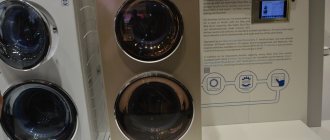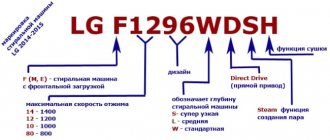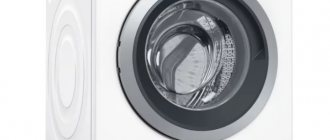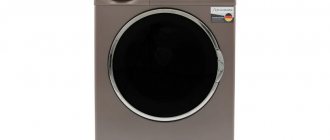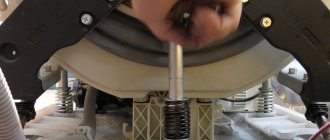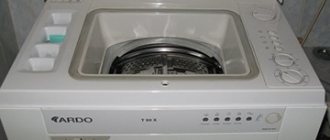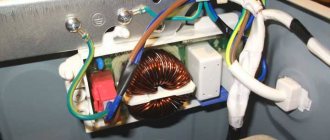What is direct drive in a washing machine
LG is an innovator in the development of machines with direct drive technology.
She owns the patent for this technology. And the first models made according to a similar scheme were presented in 2005. The drive is one of the main structural elements of the washing machine. But in the traditional version, the belt plays the role of propulsion. The use of a belt drive, which is connected to the motor through a large pulley, transmits torque to the drum shaft.
The weak link in this case is the belt, which wears out over time and can simply break, which will lead to the need for repairs. An additional negative feature of traditional units, in comparison with washing machines with direct drive, according to experts, is increased vibration and noise that occurs during the spin process.
LG direct drive washing machines do not have any elements (brushes, belts) in contact inside the body, which increases the reliability of the motor and reduces the likelihood of breakdown, and also reduces the noise and vibration produced by the device during operation.
Equipping with a direct drive allows you to increase the usable space inside the device, which leads to the possibility of increasing the drum capacity.
If in a standard washing device the process of removing dirt is carried out only from things located in the lower half of the drum, then in LG washing machines with direct drive the cleaning process occurs evenly due to reverse rotation.
Direct drive washing machines use a rotor and induction coils to convert energy.
Samsung WD70J5410AW
Another washer-dryer that, in addition to washing, offers to dry up to 5 kg of laundry using residual moisture technology. The advantage of this approach is the ability to set the level of permissible humidity, eliminating over-dried items and wasted energy consumption. This function indicates “advancement”, because the process involves two thermometers and Fuzzy Logic electronic control. Other technical characteristics are at an average level.
- Capacity about 7 kg.
- Eco Bable washing method.
- Dual-mode drying.
- Washing efficiency and power consumption classes at level A.
- Abundant rinsing due to the increased volume of water consumed per cycle of 77 liters.
- Partial protection of the housing from possible leaks.
- Locking the control panel.
- Control of drum imbalance and foam formation.
- 14 modes including delicate, economical, quick, double rinse, stain removal and soak.
- Ability to set the end of the cycle.
- Variation in water temperature.
Also available are audio, Smart Check and self-cleaning of the inner surface of the drum using Eco Drum Clean technology. Consumers note the convenience of regulating the number of required rinses in any mode, an intensive spin of 1400 rpm, additional protection on the door and a user-friendly interface. The disadvantages include a limited number of drying programs and an unreliably indicated depth with an error of 12.5 cm.
A wide range of direct drive washing machines from Samsung make it possible to choose a machine with the most suitable functionality. Especially if you are guided by the reviews given, which are based on real reviews and technical characteristics. The main thing is not to chase beautiful-sounding technologies, but to soberly evaluate the necessary and useless options and modes.
Interesting:
- Rating of Samsung washing machines
- Types of washing machine drives
- What brand of washing machine should I buy?
- How to choose a brand of washing machine?
- Models of Bosch washing machines with direct drive
- Rating of built-in dishwashers 60 cm
Reader comments
- Share your opinion - leave a comment
LG washing machine with direct drive
Direct Drive or Direct Drive is a technology that uses the principle of converting electromagnetic energy into linear or rotary motion. The design features of the engine ensure that the generated force is transferred to the rotor using an air seal, which eliminates the contact of moving parts from the operation process. This helps prevent premature wear of the motor and failure of the washing machine.
The rotor acts as part of the drum, which can perform reverse movements to improve washing efficiency.
LG direct drive machines attach the motor directly to the drum without the use of belts or pulleys. A coupling is used as a fastening element, playing the role of a moving part of the gearbox. The absence of a large number of transmission elements makes it possible to achieve a compact form for such devices.
Most LG direct drive washing models are equipped with a three-phase brushless motor, which consists of a rotor or permanent magnet and a stator with 36 inductive coils. The rotor is attached directly to the drum shaft. It turns out that the rotor shaft simultaneously sets the drum in motion, becoming part of it. The engine control process is carried out by generating an electrical signal from the controls.
Direct drive washing machines: speculation and facts
The idea of direct drive is as old as time. An infinite number of machines have been using it since time immemorial. When it comes to washing machines, LG has pioneered the use of direct drive. Probably everyone remembers the obsessive advertising of this manufacturer, which gives a ten-year guarantee on the washing machine motor. Moreover, they justified this precisely by the presence of a unique direct drive, which allows the unit to operate without problems for a whole decade.
To be honest, the majority of the population has a rather skeptical attitude towards any advertising assurances from the manufacturer - and this is not without reason. The task of advertising is to sell, and not to issue axioms for the consumer. But let's take a closer look at whether it is true that direct drive can guarantee trouble-free operation of the machine for a ten-year period.
First of all, the obvious advantage of direct drive is the relatively low noise, due to the absence of a belt and pulleys. But when the electric motor and the drum of the washing machine are on the same shaft, there is no additional point of support, which occurs when there is a pulley and a motor belt drive. Consequently, the static load on the rolling bearings in this case increases, and wear increases accordingly. The second advantage of the engine belt drive is the shock-absorbing effect of the belt, when when the laundry is unevenly loaded, it begins to beat and jerk.
There is another serious danger in the design when the drum and the engine axis are on the same shaft: if the oil seal breaks, water will inevitably enter the engine and serious damage will be inevitable. Another disadvantage is that controlling such a motor is much more complex in design, which significantly increases the cost of direct drive washing machines.
From everything said above we can draw a conclusion. Such advertising is most likely unreliable. As for the question of which parts and assemblies of washing machines most often fail, and which manufacturer most often, you can turn to statistics (which, as Ilya Ilf and Evgeny Petrov claimed, knows everything). Let us trust her, too.
Studies that were carried out simultaneously in three service centers for 100 days showed that machines of the world brands INDESIT, ARISTON, ZANUSSI, ARDO most often fail due to strong drops in supply voltage, even minor industrial noise in the network. In this case, naturally, the washer’s instrument electronics fail: memory chips, control modules and electronic boards. In most cases, the engines also break down and require replacement. Regarding SAMSUNG and LG machines, based on the statistical data provided, we can confidently say that their energy security is much better than that of the above-mentioned analogues.
20% of the total number of breakdowns occurs at pumps, and about 50% are caused by consumers who leave small items in their laundry: coins, badges, pins, and the like.
In second place are thermal power heaters (TEHs) – 16% of malfunctions.
In third place is the electronic content of the machine: boards, microcircuits, control modules - from 5 to 9.5%.
Bearings and bearing seals fail in 6% of cases, motors break down within 1.3% - 1.7% of failures. Breakdowns of tanks and drums are only 0.8%.
Other small parts: shock absorbers, door seals, locks, terminal blocks, pipes and minor leaks account for up to 27% of malfunctions.
From these above facts, an irrefutable conclusion follows: washing machine engines have a relatively low failure rate, even among brands that are not known for their reliability. On average, a replacement engine for warranty repairs is expected to be received within six months. Sometimes, without waiting for the engine from the supplier, the machine itself is simply replaced.
The average age of washing machines operating without breakdowns reaches 6-7 years. And this is regardless of the drive that is used in the design of the machine. Therefore, to take credit for the uninterrupted operation of a machine for 10 years solely because of its direct drive is, to put it mildly, incorrect.
Back to list
LG direct drive washing machines: general technical specifications
The presence of the Direct Drive system has virtually no effect on the technical characteristics of washing machines. The only important difference is the structural feature of the motor used, which is called an inverter.
Inverter motor
What is LG Direct Drive Inverter Washing Machine? The invention of this type of engine is credited to an engineer from a famous Korean company. This type is used in all machines with direct drive.
The operating principle of the motor is that the rotation speed is formed through the use of a private converter called an inverter. Its task is to convert alternating current into direct current, which allows the output to achieve alternating current again, but at a certain frequency.
The use of such technology helps to obtain the most accurate adjustment of the rotation speed and ensures that the frequency is maintained at the proper level.
The advantages of this technology include:
- reduction of energy consumption – increase in efficiency due to reduction in the number of rubbing parts;
- increasing service life;
- reduced noise and vibration levels;
- high spin speed due to increasing the number of drum revolutions to 2000 per minute;
- smoother starting, preventing engine wear.
Washing modes
In the line of direct drive washing machine models from LG, there are samples that offer unique washing modes associated with an increase in the number of drum rotation options. Their number can reach six.
- Standard type.
- Reverse, the purpose of which is to better dissolve the detergent.
- Pumping, which is needed when soaking dirty laundry.
- Twist suitable for normal washing.
- Saturation, during which the uniform distribution of the detergent composition over the loaded laundry is ensured.
- Smoothing. A mode that ensures proper stretching of items, which subsequently simplifies the ironing process.
As for the laundry washing modes, LG direct drive washing machines (see photo) use standard programs:
- “cotton” for washing thick fabrics made from cotton threads. It uses elevated temperatures for heat treatment;
- “quick clap”, in which the cycle time is shortened and the temperature drops;
- "fast 30". A program that allows you to refresh things with a cycle duration of only half an hour;
- “synthetics”, used to clean things made of nylon or acrylic at a temperature of 40ºC;
- “delicate wash” for processing items at a temperature of 30ºC for an hour;
- “wool” or “hand wash”, characterized by a slower drum speed;
- “children's clothing”, which is distinguished by more abundant rinsing and increased washing time.
Additional options
LG includes additional options in its washing machines that may not be used as often, but are required for special care of laundry. Among them are:
- bio-care, which is used to remove stubborn stains (chocolate, wine, blood). During the washing process, the special enzymes contained in the powder are completely broken down for a better effect on dirt;
- Steam cleansing – True Steam option. When washing clothes, steam is mixed with water, which allows for the complete elimination of household allergens and bacteria. This program also smoothes out wrinkles and removes odors;
- TurboWash. A mode in which the washing time is reduced to 59 minutes, while saving water and electricity;
- hypoallergenic. An option that uses abundant rinsing to completely remove powder residues, dust, hair and other allergens.
The “refresh” option, which differs from regular washing, is used when it is necessary to refresh items that have been lying around for a long time. The washing time is reduced to 20 minutes.
Which washing machine is better - direct drive or belt driven?
Created: 07/20/2020
Updated: 01/29/2021 13:37:19 Share:
When choosing a suitable washing machine, consumers try to take into account the maximum number of factors (drum volume, energy efficiency, spin cycle, number of programs) to make the purchase successful. But in recent years, new models of washing machines have appeared on the market, differing in the basic principle of operation, which also greatly affects the quality of work. How does this manifest itself and how do belt and direct drive products differ from each other? More on this below.
Washing machines with belt drive: features, advantages
Belt-driven household appliances have been on the market for quite some time and are still very popular among consumers. The key feature of such products can be seen in their very name: the machine is driven by a belt, which is mounted on a pulley of the motor shaft.
The movement of the drive belt ensures that the washing machine drum moves and stops. The rotation of the drum, remarkably, is quite smooth (thanks to the elastic surface of the fabric base on the inside of the belt). The intensity of rotation is regulated by the built-in motor. For belt drives, 2 types of motors are used:
- Asynchronous – three-phase, compact motors with the ability to regulate the speed. They consist of 2 main elements - the stator (fixed part) and the rotor (rotating element). They are installed mainly in budget models of washing machines.
- Collector motors, unlike asynchronous ones, have a built-in tachogenerator (controls the rotational force, lowering/increasing the current on the windings) and are additionally equipped with special brushes, the task of which is to smooth out friction and reduce current transmission. It is commutator motors that are installed on more than 80% of all household appliances.
In belt-driven washing machines, 2 types of belts are used: V-shaped (single-ribbed) and poly-V-shaped (multi-ribbed). In modern models, the second type predominates due to its design features. Poly-V-belts are distinguished by their impressive width; their entire surface consists of several “rivulets”, each of which falls into its own groove on the pulley when moving.
This design provides excellent grip and, accordingly, better torque transmission. Poly V-belts are considered the most durable option. And replacing an element that has become unusable is not difficult, especially since its price is very low.
Main features of belt driven washing machines:
- Long service life – up to 15 years;
- The belt experiences the main load - replacing it is as easy as shelling pears, especially since the process is not particularly expensive;
- The belt can act as a shock absorber - important when distributing laundry unevenly.
Direct drive washing machines
History of origin, principle of operation
For many years, housewives around the world enjoyed using belt-driven appliances in their everyday lives, which faithfully performed their function for a long time (the service life reached 10 years). But one day the famous Korean brand LG decided to introduce its know-how, coming to the idea that washing machines should be quieter, more productive and generally become more energy efficient.
This is how the first models of washing machines that operated directly from a motor appeared on the household appliances market. The brand's PR campaign for the new product was so powerful and impressive that many other venerable brands followed the lead of direct drive technology. Technological development is always good.
But the introduction of direct drive household appliances to the market led to even more questions for consumers: in addition to choosing the appropriate volume, dimensions, loading type, energy efficiency, buyers also had to deal with drive types.
So how does direct drive work? Unlike belt-driven models, where the drum is driven by a belt and pulley mounted on a motor, direct drive washing machines are equipped with an electric motor that is mounted directly on the drum. In this case, the latter is driven directly by the engine.
This means that the drum becomes more maneuverable: it picks up speed faster and reverses easier. And the engine itself lasts longer - due to the absence of a number of auxiliary elements, the engine does not need to do extra work. Direct drive motors can be called more energy efficient than belt drive motors. But, as practice shows, the difference is not so significant.
Key Benefits
Since direct drive is an innovative product, it is quite difficult to find reliable information from SMA users who have tested similar washing machines in practice (advertising slogans of manufacturers are not taken into account). Taking into account all the information received from consumers, we can highlight several important advantages of direct drive machines:
- Large capacity with compact dimensions - unlike belt models, direct-drive washing machines do not have brushes, a pulley, or a belt, which makes it possible to increase the working space of the drum and at the same time reduce the dimensions of the device body.
- Reduced level of vibrations and noise - but the difference is insignificant, since the noise from the belt in belt models is comparable to the noise from the intake and drainage of water in direct drive machines.
- Washing quality - experts say that the special operating cycle of the inverter motor, which operates with sudden stops and reverse, improves the quality of washing clothes.
- Energy savings are achieved by eliminating some elements from the rotation cycle and the ability to control power automatically (the machine reads the weight of the laundry).
- Long motor life – Direct drive washing machine manufacturers offer a 10-year warranty on the motors used in the products they create.
- Diagnosis of problems - the “Direct Drive” system signals an excess of laundry in the tank, displaying the corresponding errors.
- Accelerated washing - the previously mentioned specificity of the inverter motor ensures faster cycle rotation, which makes it possible to save a little time.
But we must not forget about the specific features of direct-drive washing machines: vulnerability to power surges (the power supply for such devices must be uninterrupted), oil seal leakage if it is not replaced in a timely manner (the manufacturer’s warranty does not cover such a malfunction, and replacing the oil seal is an expensive pleasure).
Comparative characteristics
| Belt drive | Direct drive | |
| Design Features | The motor is located at a distance from the drum, a pulley is attached to the motor shaft, and a belt is mounted on it | The motor is attached directly to the drum |
| Operating principle | The drum is driven by a belt | The drum is driven directly by the engine |
| Sensitivity to voltage changes | No | Yes |
| complexity of operation | Possible failure of the belt (changes quickly, is inexpensive) | The seal may fail (this could result in a flood in the bathroom; replacement will be expensive) |
| Noisiness | Average | Low |
| Power consumption level | High | Short |
| Life time | Up to 10 years | Up to 10 years |
| Price | Average | Above average |
Rate this article |
| Total votes: 0, rating: 0 |
Advantages and disadvantages of direct drive machines
Like any other equipment, washing machines that use direct drive technology have their strengths and weaknesses. The advantages of this technique can be considered:
- the minimum number of contacting parts ensures long-term operation without the need for repairs;
- low noise and vibration levels due to balanced drum operation;
- no need for frequent engine maintenance;
- higher dynamics of drum rotation increases washing efficiency;
- increased tank width due to free space inside the housing.
The disadvantages of direct drive machines, according to users, are:
- higher cost, which is almost twice the price tag of a conventional device;
- expensive repairs, especially if the electronic unit breaks down.
Direct drive. Advantages and disadvantages
Pros of direct drive
- In the design of a direct drive washing machine, the number of fragile parts and quickly wearing parts is much less than in devices with belt transmission. That is why LG is so confident in the quality of its equipment that it gives such an engine a 10-year warranty.
- Of the sounds familiar to all of us that Direct Drive washing machines can produce, you will only hear the measured rustling of the laundry in the drum.
- Due to the fact that belt drive technology is not used, the stability of the device is significantly increased . Thanks to the use of direct drive in washing machines, the operation of the drum is as balanced as possible.
- Such engines do not require constant maintenance. maintenance and regular lubrication.
- Direct drive machines can automatically detect the level of load on the drum and the weight of the laundry, which will allow you to select the best power and avoid wasting water and electricity. Thus, savings due to this technology sometimes reach up to 30%.
Disadvantages of direct drive
High cost of the machine
One of the disadvantages of direct drive washing machines is their high price. In this price range there are many simple and reliable models from many other manufacturers that have performed well in the home appliance market.
The high cost in such models is due to the very complex design of the module, which is necessary to control the operation of the electric motor.
Another disadvantage is the high price of the components - if you have repair work on such a machine, you will have to spend a tidy sum of money.
Dependency on good electricity
Direct drive in washing machines makes the device more vulnerable to power surges.
In this case, in order to insure yourself against expensive repair work, we advise you to immediately install a voltage stabilizer.
Liquid in the seal
Avoiding leaks is possible by regularly replacing the oil seal.
In direct drive washing designs there is a small chance of liquid getting into the seal.
This situation is not considered a warranty case and the engine cannot be repaired.
Noise
Some users complain about loud noise when draining and drawing water during washing.
Rapid bearing wear
The fairly close location of the bearings and the complete absence of a pulley increases the load. This will cause them to wear out faster, and from time to time you will have to replace them, which, as we said, is quite expensive.
Which direct drive washing machine from LG is better to buy?
The line of models from the famous Korean brand contains dozens of samples, each of which is a quality product. But among them the best representatives can be distinguished.
LGF-12U2HDM1N
The machine is small in size, with a depth of only 45 cm. This model is considered one of the best in the company’s line. The spin speed is 1200 rpm, there are 14 washing programs for the user's needs, TurboWash and True Steam technologies are also present. An additional advantage is the presence of the Tag On function, which allows you to set the program through a mobile application. Disadvantages include the absence of a power button lock and the possibility of high-quality drying only when the drum is not fully loaded.
Price: ₽ 30,000
LGF-4J9VS2S
In the category of full-size devices, the leader in the rating is the LGF-4J9VS2S model, the maximum load of which is 9 kg. There are 14 washing programs and a steam cleaning function. The presence of a bubble drum ensures the most gentle treatment of laundry. The spin speed is 1400 rpm. The device also has the option of control from a mobile device. The only drawback can be considered the high price.
Price: ₽ 41,000
LGF-2J7HS2W
Another leader in the user rating, but now in the category of narrow machines with a width of up to 45 cm. Maximum load - 7 kg, spin speed - 1200 rpm. There is a bubble drum, steam treatment, and the “Add laundry” option. The device can be controlled via Wi-Fi. The large loading hatch allows you to wash large items. Additional advantages include a self-cleaning drum, a convenient display, and intelligent washing with water dosing. The model has one obvious disadvantage: the inability to spin clothes without pre-rinsing. The appearance of hum, noise, or strong vibration may indicate bearing failure. In this case, qualified repairs in a workshop are required.
Price: ₽ 34,000
LG direct drive washing machines: common faults
Despite the almost perfect technology, which has many advantages, devices from the Korean brand can break. Here is a list of the most common faults.
- Pump failure. Most often, this is the fault of the users themselves, who do not take small items out of their pockets, which leads to clogging of the pump and drain.
- Problems with the heating element. The causes of problems with the heating element are poor water quality, voltage fluctuations, and the use of low-quality descaling agents.
- Damage to the electronic unit. A rare and very expensive problem to repair. The most common cause is power surges. To prevent damage, it is recommended to entrust the installation to a specialist and operate the equipment carefully.
- Bearing failure. When your LG direct drive washing machine hums, the noise may be caused by broken bearings. At the same time, the drum also stops rotating, washing is not performed, and an error is recorded on the display. The only way to repair is to replace parts.
- Engine problem. The first reason for its damage is leaks, since it is located in close proximity to the drum.
As preventative measures that will help increase the life of equipment and prevent breakdowns in the future, experts recommend the following.
- Installation should only be carried out with the assistance of a professional.
- Use a separate outlet to connect the machine to prevent power surges.
- Install the device only on a smooth and level surface.
- Install a special water filter.
- Get rid of scale using quality products.
- Before each stowage of linen and clothing, check pockets for small items.
- After every 15 operations, start the drum cleaning mode.
How to Extend the Life of a Direct Drive Machine
As you know, trouble is often easier to prevent than to eliminate its consequences. This also applies to washing machines. If you know how to properly care for your washer, and most importantly, don’t be lazy about doing it, the equipment will serve you faithfully for many years:
- To begin with, don’t neglect prevention. Even if nothing bothers you about the operation of the machine, once every three to four years it is worth inviting a specialist who will examine your assistant, carry out preventive maintenance, where it is necessary to lubricate and tighten connections, and replace worn parts.
- To avoid leakage on the engine, you need to change the oil seal in a timely manner. It is also better to entrust this procedure to a specialist.
- Bearings also require regular replacement. You should not bring them to the point where they crumble on their own.
- To protect an expensive electronic control system from sudden power surges, it is recommended to equip it with a separate outlet and protection against voltage surges. This may seem like an unnecessary expense, but if the washer’s “brains” burn out as a result of a power surge, repairs will cost a disproportionately large amount.
- To protect internal parts (heating elements) from scale and salt build-up, it is worth installing a special filter at the inlet. It will soften the water and extend the life of your home assistant.
Now you know what direct drive is in a washing machine and, taking into account all the above conditions, you can choose the best option for yourself. It’s worth approaching the issue responsibly and a direct drive washing machine will serve you faithfully for many years.
See also:
- 7 best washing machines under 20,000 rubles according to customer reviews
- 8 best narrow washing machines according to customers
- 8 best BEKO washing machines according to customer reviews
- 10 best washing machines from Samsung
- 10 Best Top Loading Washing Machines
